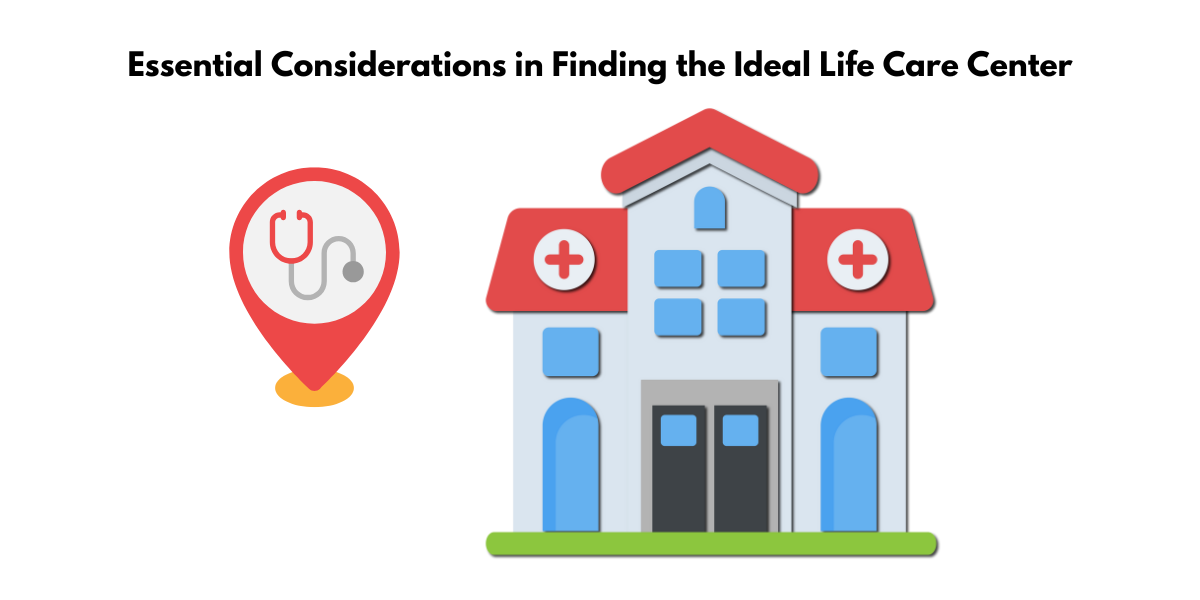Choosing the Right Life Care Center: Key Factors to Consider
Opening the Door to Recovery
Embracing a Holistic Approach to Rehabilitation
When you’re on the path to recovery, considering a holistic approach to rehabilitation can make all the difference. Premier life care centers recognize the importance of treating the whole person, not just the symptoms or the injury. This means tailoring therapy options to address everything from physical challenges to emotional well-being in support of complete, holistic recovery.
Quality Care at Your Fingertips
Quality care is more than a goal; it’s a commitment that top rehab centers live by. When you decide on a life care facility, you’re choosing access to a team of caring professionals who provide exceptional services. These centers offer state-of-the-art medical care while also prioritizing comfort and convenience. With flexible visiting hours, a variety of on-site amenities, and personalized treatment plans, quality care is always within reach.

Navigating the World of Life Care Rehab Centers
What Sets Top Life Care Facilities Apart
Top life care facilities distinguish themselves through a combination of their highly skilled staff, comprehensive services, and the nurturing environments they create. They stand out by offering specialized care units, such as for Alzheimer’s and dementia care, and a range of rehabilitation services. Furthermore, their commitment to utilizing the latest healthcare technologies and methods means that patients receive cutting-edge treatment in a supportive, homelike atmosphere.
- Individualized care plans
- Expertise in complex health conditions
- Advanced rehabilitation equipment
- Compassionate, round-the-clock staffing
- A seamless transition between different levels of care
Services and Amenities Offered by Premier Centers
Premier life care centers offer an impressive array of services and amenities to cater to the diverse needs and preferences of their residents. From furnished accommodations easing the transition into the facility, to community-sponsored activities that foster a sense of belonging, these centers focus on creating a vibrant, holistic living experience. Key offerings include emergency alert systems for safety, move-in coordination for a stress-free transition, chef-prepared meal services, and diversified wellness programs that emphasize physical fitness and mental health.
- Concierge services for personal assistance
- Diverse meal options catering to special dietary restrictions
- Housekeeping to maintain a clean and comfortable living space
- Fitness programs tailored to individual abilities
- Engaging social activities such as movie nights, arts and music programs, and resident-run activities
Understanding the Life Care Advantage
The Intersection of Cutting-Edge Technology and Compassionate Care
The fusion of innovative technology with compassionate care is at the heart of modern life care centers. State-of-the-art medical equipment and evidence-based therapeutic practices ensure that patients receive the highest standard of care with a personal touch. It’s a powerful partnership that fosters healing and comfort. Patients benefit from advanced monitoring systems, telemedicine options, and sophisticated therapy equipment – all delivered by empathetic caregivers who understand the importance of a kind word and a gentle touch.
- Access to telehealth services for remote consultations
- Advanced monitoring systems for optimal patient care
- Rehabilitation equipment utilizing the latest technology
- Personalized interaction to support mental and emotional health
- Continuous staff training to keep up with healthcare innovations
Tailored Therapies: Meeting Individual Patient Needs
Every journey to recovery is unique, and acknowledging this, top life care centers develop tailored therapy programs to meet the individual needs of each patient. Personalized care plans are crafted after thorough assessments by multidisciplinary teams, ensuring that each therapy session is aligned with the patient’s specific health goals and challenges. Whether it’s occupational therapy to regain daily living skills or physical therapy to restore mobility, therapies are customized to optimize recovery and enhance quality of life.
- Adaptive therapy techniques suited to individual progress
- Integration of patient preferences and hobbies into therapy
- Goal-oriented programs for measurable improvements
- Close monitoring and adjustments to therapies as needed
- Collaboration with family and other care providers for a cohesive approach

Making Informed Choices for Your Journey to Health
Decoding the Ratings: What They Mean for You
Deciphering the ratings of life care centers can be crucial when making informed decisions about which facility is right for you or your loved one. The Seniorly Community Score, for example, is a comprehensive measure that combines user-submitted reviews, neighborhood safety, and livability data, among other elements. A higher score signifies a better overall community experience. Pay attention to the nuances in ratings; a facility with high marks for short-term rehabilitation might have different scores for long-term care, indicating specific strengths and areas for improvement.
- Rating breakdown helps prioritize what’s important to you
- Insights from recent reviews and user feedback guide expectations
- Safety and neighborhood scores indicate the quality of the surrounding area
- Comparison between facilities can clarify your best fit
- Recognition of a community’s continuous efforts to improve their services
Financial Considerations: Insurance and Payment Options
Understanding and navigating financial considerations are pivotal when choosing a life care center. Most centers offer a variety of payment options to alleviate financial strain, including accepting long-term care insurance, bridge loans, VA assistance, and the possibility to utilize life insurance policies. Furthermore, these facilities often help in managing funds from selling a home or obtaining personal loans. It’s essential to explore these options, understand the costs involved, and align them with personal financial planning.
- Various financing options to suit different budgets and financial resources
- Staff available to discuss and help understand insurance benefits and limitations
- Pros and cons of different payment methods such as out-of-pocket vs. insurance
- Assistance with applications and paperwork for VA benefits and other assistance programs
- Customized pricing plans for individual care needs
Staying Engaged: Life Care Center Activities and Community
Beyond Treatment: Enrichment Programs for Patients
Life care centers recognize that recovery extends beyond medical treatment, thus offering enrichment programs to boost morale, engagement, and overall well-being. These programs include music and arts therapy, which offer creative outlets for self-expression, and community-sponsored activities, fostering a sense of inclusion. For the body, there are fitness and aquatic therapy sessions, all designed considering varying degrees of mobility. Enrichment programs are not just additional services; they are integral to the holistic healing journey that life care centers promote.
- Creative programs to stimulate the mind and nurture the spirit
- Physical activities tailored to improve strength and mobility
- Social gatherings to maintain connections and community ties
- Educational workshops to promote lifelong learning
- Spiritual support and services for diverse belief systems

Family Support and Resources Offered by Rehab Centers
Life care centers extend their support beyond patients, recognizing family involvement as an integral part of the recovery process. Facilities offer resources such as family counseling to help relatives cope with the challenges of a loved one’s recuperation. They also provide educational sessions to keep families informed on progress and care techniques, and invite them to participate in care planning sessions. Some centers also connect families with community support groups for additional guidance and emotional support.
- Educational resources to better understand the recovery process
- Counseling services to offer emotional support for family members
- Regular updates and meetings to include families in care decisions
- Support groups connecting families with similar experiences
- Resource centers with materials on post-discharge care and community services
Preparing for Your Stay at a Life Care Rehab Center
Essential Items to Bring for Your Comfort and Well-being
When preparing for a stay at a life care rehab center, it’s vital to pack items that will contribute to your comfort and well-being. These might include personal items like family photos or a favorite blanket that bring emotional comfort, as well as practical items such as comfortable clothing and toiletries. Remember to include necessary assistive devices, like glasses or hearing aids, and any preferred entertainment like books or a tablet. Make sure to consult with the center for any specific items they recommend or provide.
- Personal items that bring emotional comfort and a sense of home
- Comfortable clothing suitable for therapy sessions and rest
- Toiletries, assistive devices, and any medical equipment not provided by the center
- Entertainment options to stay engaged during downtime
- Any specific items requested by the center based on individual care needs

Getting Acquainted with Your Care Team and Environment
Feeling comfortable in your new environment and with the team entrusted with your care is essential for a positive experience. When you arrive at the life care center, take the time to meet and interact with the various professionals who will be part of your recovery journey—from nurses and therapists to the support staff. Familiarize yourself with the facility’s layout and amenities, ask questions, and express any concerns you may have. Understanding the daily routines and available resources can significantly ease the transition.
- Introductions to key staff members to build a relationship of trust
- Orientation tours to get familiar with the center’s facilities and amenities
- Clear communication about routines and how your daily needs will be met
- Encouragement to ask questions and provide feedback
- Assistance in setting up personal spaces to feel more at home
Success Stories from Life Care Patients
Personal Triumphs in Healing and Restoration
The personal stories of patients who have faced challenges and achieved remarkable progress are at the heart of a life care center’s mission. These narratives of triumph in healing and restoration are living proof of the resilience of the human spirit when supported by excellent care. You might hear about someone reclaiming their independence after a severe injury or another regaining the ability to speak after a stroke. Each story is unique, but all share a common theme of hope and determination.
- Inspiring accounts of patients overcoming significant health obstacles
- Demonstrations of the effectiveness of personalized care and therapy
- Motivation for current and future patients in their own journeys to recovery
- Evidence of the life-changing impact of skilled and compassionate care teams
- Celebrations of milestones and achievements big and small during rehabilitation
Celebrating Progress: Testimonials and Outcomes
Celebrating each step forward is crucial in the rehabilitation journey. Life care centers showcase patient stories and testimonials that highlight individual progress and successful outcomes. These testimonials often include before-and-after scenarios, detailing the patient’s condition at admission and upon completion of their rehab program. These success stories serve as powerful endorsements of the center’s ability to deliver on their promises of excellent care and support, reinforcing the impact of their compassionate approach.
- Testimonials from patients and families sharing their experiences and recovery milestones
- Data and statistics highlighting treatment success rates and patient satisfaction
- Awards and recognitions received by the life care center for quality of service
- Visuals such as progress graphs or recovery journey timelines
- Patient interviews or videos sharing firsthand accounts of their rehabilitation experience

Frequently Asked Questions
How Do I Choose the Right Rehab Facility for My Needs?
To choose the right rehab facility for your needs, consider the specific type of care and therapy required for your condition. Look for facilities with strong experience in those areas, and compare their ratings and patient reviews. It’s also important to visit the centers if possible, meet with staff, and ensure the amenities match your requirements. Additionally, verify they accept your insurance, understand the costs involved, and review their policies on family involvement and support.
- Evaluate the facility’s specialty and expertise in your specific rehabilitation needs
- Consider the location, amenities, financial options, and overall community fit
Can Family Members Be Involved in the Rehabilitation Process?
Absolutely, family members can and are often encouraged to be involved in the rehabilitation process. Their participation can include attending care planning meetings, participating in therapy sessions, and learning about the patient’s care regimen. Life care centers may offer training and support for families to carry on care practices at home, enhancing the patient’s recovery journey.
- Inquire about the facility’s policies on family participation and support tools provided
- Take advantage of resources like family education programs and support groups offered by the center
What Should I Expect in Terms of Recovery Time?
The recovery time can vary significantly based on the individual’s condition, the severity of the injury or illness, and their overall health. While some may experience rapid improvement, others require long-term rehabilitation. Life care centers personalize recovery plans to set realistic time frames, with regular evaluations to adjust as needed. It’s important to maintain open communication with your care team for the most accurate expectations.
- Discuss with care providers for an estimated recovery timeline based on individual circumstances
- Understand that progress can be nonlinear and adjustments to the recovery plan may be necessary
How Are Life Care Facilities Managing COVID-19 and Other Outbreaks?
Life care facilities have implemented stringent measures to manage COVID-19 and other outbreaks, prioritizing the health and safety of residents and staff. These protocols include regular health screenings, enhanced cleaning procedures, visitor restrictions when necessary, and isolation procedures for symptomatic individuals. They also stay updated with public health guidelines to ensure best practices in infection control.
- Check the facility’s current infection control protocols and vaccination policies
- Understand the communication process for updates on any health-related incidents within the center

